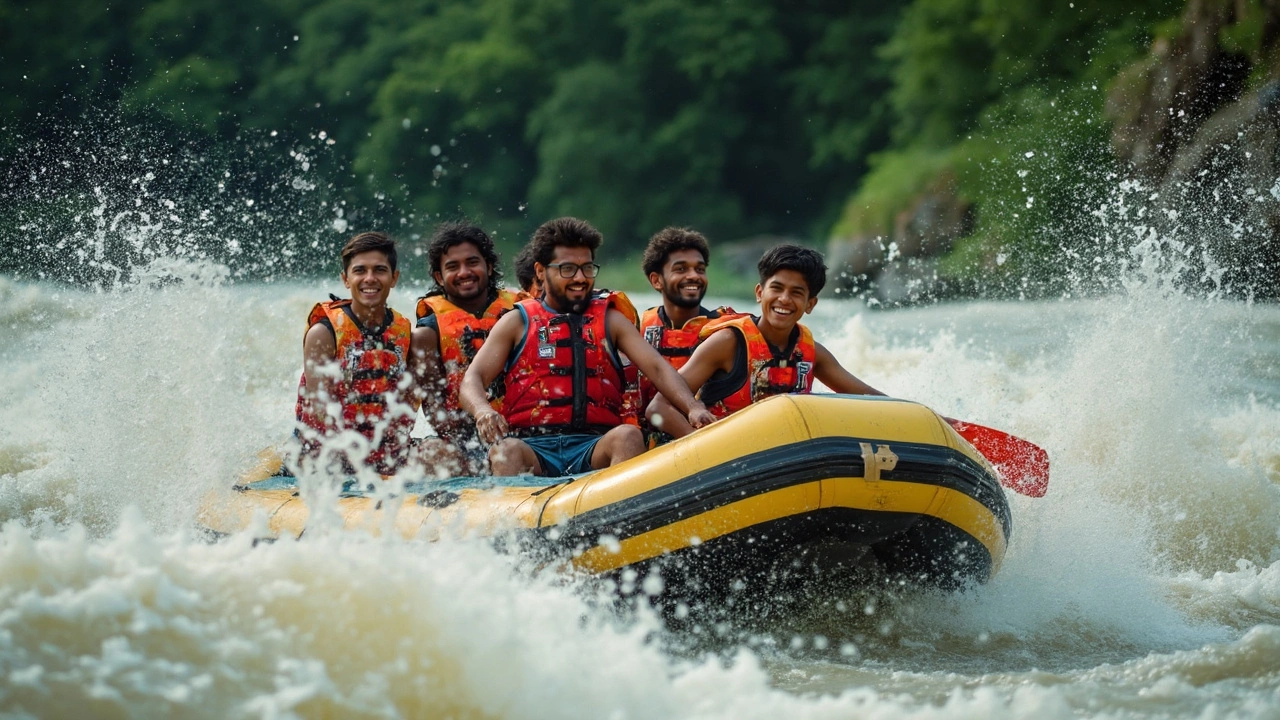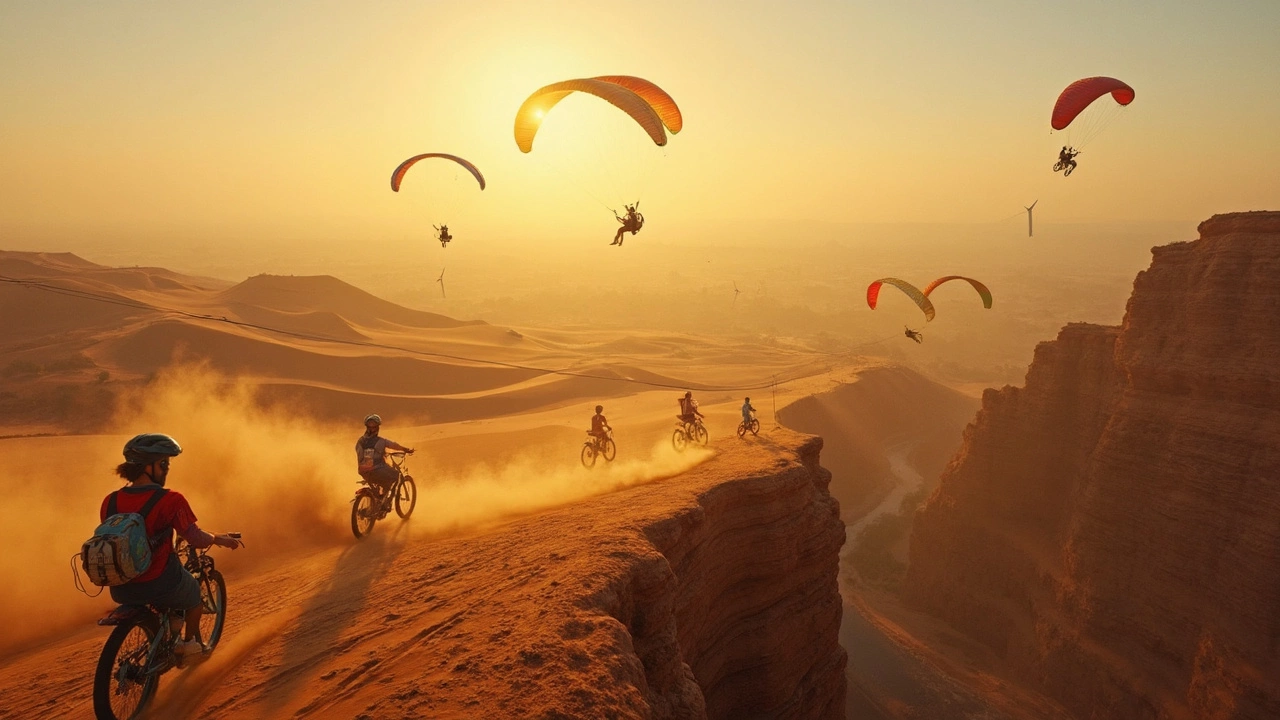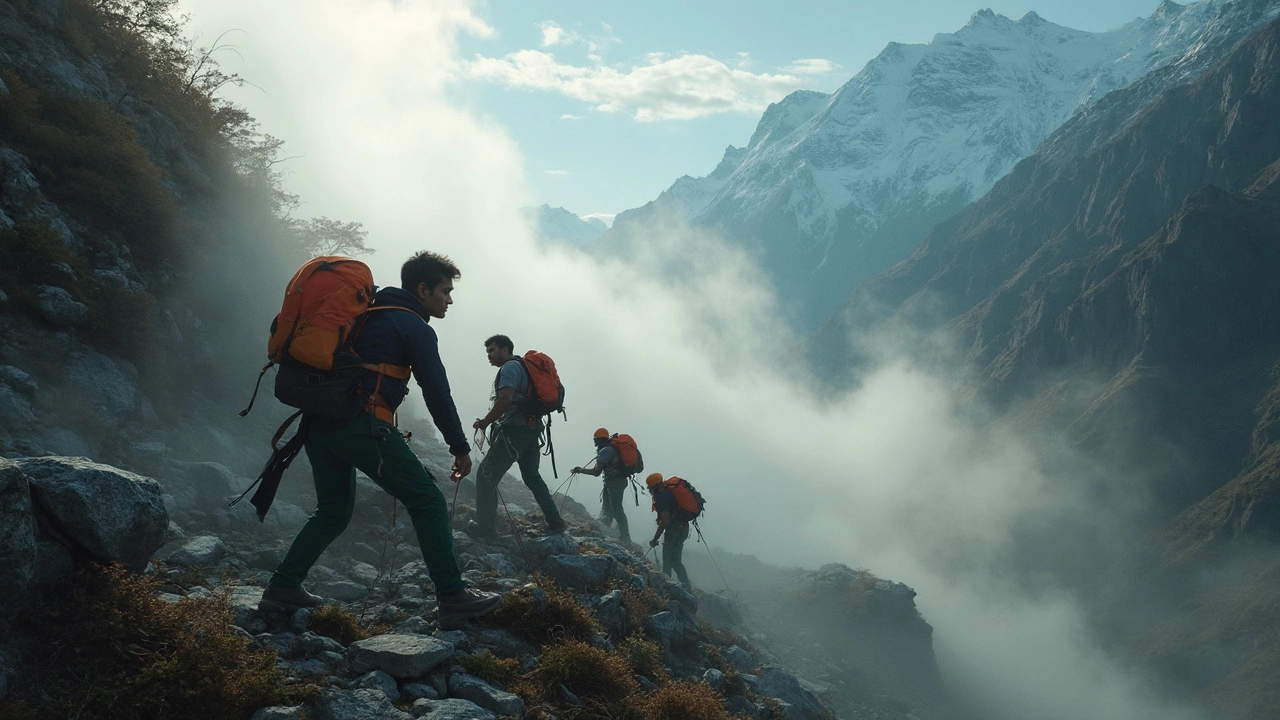Think skydiving is wild? Wait till you see what else India has lined up. Sure, jumping out of a plane gives a crazy rush. But there’s stuff here that'll actually make your stomach drop even harder—sometimes literally. And you won’t need to fly abroad or break the bank just to get that next-level thrill.
Ever tried bungee jumping off a bridge in Rishikesh? People call it the highest in India, and the freefall is so raw it will leave your legs shaking. Maybe white-water rafting down the churning Zanskar river or ziplining across the crazy deep valleys of Meghalaya sounds more your style. There’s more: paragliding over the snow-capped hills in Himachal, or caving inside the dark, mysterious places under Meghalaya, where one wrong step means a real adventure.
You don’t have to be a pro to start, either. Tons of places now offer beginner-level training, solid guides, and all the gear. Bring your courage, and maybe an extra set of clothes—trust me, you’ll need them.
- Skydiving: The Gateway Rush
- Top Adventures That Outdo the Freefall
- India’s Wildest Spots for Extreme Thrills
- What to Pack: Gear for Each Adventure
- Survival Tips: Staying Safe While Going Wild
Skydiving: The Gateway Rush
If you’re talking about adventure sports India style, skydiving is always the first thing people want to try. Seriously, who wouldn’t want to feel the wind slap their cheeks at 200 kmph? In India, skydiving is catching on quick and it’s not just for daredevils. It’s your golden ticket into the world of extreme sports if you want something to brag about over dinner.
Major skydiving spots are popping up all over. You’ve got Mysuru in Karnataka, Aligarh near Delhi, and Deesa in Gujarat, each with certified instructors and all the gear you need. The jump itself is usually from around 10,000–13,000 feet. For first-timers, there’s tandem skydiving. That means you’re strapped to a pro who makes sure you don’t mess up. After a quick ground briefing (think 30 minutes to an hour), you’re up in the plane, gearing up for that heart-drop moment.
Here’s what most folks wanna know before the jump:
- Cost: Expect to pay anywhere from ₹25,000–₹35,000 per jump for tandem skydiving. Packages usually include video, so yeah, your friends get proof you actually did it.
- Requirements: You have to be at least 18, fairly healthy, and under 90kg for most operators. Bring an ID and have a basic health check done.
- Season: Ideal months are October to March, when the sky is clear and winds aren’t crazy strong.
Stats say that India saw almost a doubling of skydiving bookings in 2024—especially around Mysuru, which led the pack in number of jumps. This is probably because the views there are wild: sprawling fields, blue skies, and zero traffic jams in sight.
Most big operators use rigs that meet global safety standards—so no, your parachute is not going to malfunction Bollywood-style. If you’re feeling gutsy after your first tandem jump, you can sign up for solo training. That’s when things get fun, but also, way trickier.
This is where most folks catch the adrenaline bug. One jump and suddenly, you’re itching for the next wild thing. It’s the perfect starting point before you try adventure sports that crank up the fear factor even more.
Top Adventures That Outdo the Freefall
If you think skydiving is the be-all and end-all for adventure sports India, that’s just the starting line. India’s totally upped its game—some sports will leave you questioning your sanity (in a good way). Here are huge adrenaline hits that go toe-to-toe with—or even outdo—the skydiving rush.
Bungee Jumping in Rishikesh
Take the country’s tallest jump at Mohan Chatti, where you fall 83 meters straight down. The bridge shakes. You scream (everyone does). The rebound makes your heart do cartwheels. It’s designed by experts from New Zealand—the country that practically invented the sport. It’s crowd-checked and super strict with safety, so no cowboy operators here.
White Water Rafting in Zanskar and Tons
The Zanskar river in Ladakh churns out Grade IV rapids, which isn’t just "bumpy"—it’s "hold on for dear life." You’ll slam through freezing water between mighty Himalayan cliffs. A few operators even offer multi-day expeditions if you’re up for it, or you can try the Tons river in Uttarakhand, one of the trickiest in Asia. Pretty wild for something you do sitting down, right?
Cliff Climbing in Hampi
Thousands flock to Hampi for epic temples, but rock climbers know it for its bouldering paradise. Not only do you scramble up weird granite formations, you also do it with zero ropes in some spots. Spots like the "Laughing Buddha" boulder attract top climbers from around the world. Guides know the safe routes, and you can rent crash mats from any local shack.
Caving in Meghalaya
This isn’t some touristy stroll with fairy lights. Meghalaya has India’s deepest and longest caves, with tight squeezes, underwater passages, and actual bats flying overhead. The Krem Liat Prah cave is a real beast—over 30km mapped, but lots is still unexplored. You’ll need a helmet, headlamp, and nerves of steel. Most trips run between October and March when the water level’s not stupid high.
Paragliding in Bir-Billing
This is where the world comes to fly. Bir-Billing hosts world championships for a reason: you leap off a cliff and catch Himalayan thermals that keep you airborne for up to 30 minutes. That’s half an episode of your favorite show—except the view is unreal, and you’re literally gliding with the eagles. Top operators use imported gear; it all meets strict international safety checks.
Quick glance at how they stack up:
| Adventure | Biggest Spot | Peak Season | Unique Thrill |
|---|---|---|---|
| Bungee Jumping | Rishikesh | Sept. - June | 83m freefall with pro-built setup |
| White Water Rafting | Zanskar | July - Sept. | Wild Himalayan rapids |
| Cliff Climbing | Hampi | Nov. - Feb. | Bouldering with global legends |
| Caving | Meghalaya | Oct. - Mar. | Deep, wild cave systems |
| Paragliding | Bir-Billing | Mar., Oct. - Dec. | World-class mountain airtime |
The best part? You can try all these even if you’re not a seasoned athlete—just follow the local pros, stick to starter packages, and don’t skip the safety talks. No shame in a little nervous laughter either. That’s just your body saying you’re seriously living.

India’s Wildest Spots for Extreme Thrills
If you’re hunting for adventure sports India experiences that absolutely crank up the crazy, you’ve got some wild choices. The action is spread all over—some spots have become legends for their unique mix of danger, scenery, and pure adrenaline.
- Rishikesh: Known for bungee jumping and white-water rafting. The Jumpin Heights bungee platform here is about 83 meters, the tallest in India. Rafting on the Ganges gives a rollercoaster ride during May–June with rapids nicknamed ‘The Wall’ and ‘Golf Course’ for a reason.
- Bir Billing, Himachal Pradesh: If paragliding is on your bucket list, this is the place. It hosted the Paragliding World Cup in 2015. You get clear air, dramatic mountain backdrops, and the take-off is from a 2,400-meter hill. Tons of operators offer tandem flights, so even newbies can join the fun.
- Meghalaya: The state’s got wild ziplining and caving. Mawkdok Dympep Valley zipline is 2,600 feet long—takes less than a minute, but the rush is ridiculous. Caving in the Khasi Hills (places like Siju or Mawsmai) feels like stepping onto another planet and can get pretty technical.
- Ladakh: River rafting in Zanskar is not just about rapids, it’s about biting cold and massive gorges. Season runs from June to September and trips can last several days, camping out at night. The rafting distance can easily top 100 km, and the remoteness makes the adrenaline kick double.
- Goa: Don’t just think beaches and parties—get into kite surfing, scuba diving, and even flyboarding on the backwaters. Operators at Baga and Calangute have introduced new gear and courses, so it’s not just for pros anymore.
If you’re curious how risky it feels for first-timers, here’s a quick look from published safety and popularity numbers:
| Location | Adventure | Main Season | Safety Record |
|---|---|---|---|
| Rishikesh | Bungee, Rafting | Oct–June | Trained instructors, strict checks, low incident rate |
| Bir Billing | Paragliding | Mar–June, Sep–Nov | World Cup tested, professional pilots |
| Ladakh | Rafting | Jun–Sep | Expert guides, mandatory gear |
| Meghalaya | Zipline, Caving | Oct–Apr | Checked equipment, guided tours |
Whatever you’re after, there’s something wild for every level. Just make sure you check with local operators for the latest on safety and weather. Most spots get busy during holiday periods, so if you want less crowd and more adventure, hit the shoulder seasons or book early.
What to Pack: Gear for Each Adventure
Packing right can make or break your adventure sports India experience. Don’t just throw a GoPro and a t-shirt into your bag. Each adventure needs its own set of essentials, and trust me, some little details make life way easier out there.
- Skydiving: You won’t need a parachute—centers supply those. Bring close-fitting, weather-appropriate clothes, sturdy sneakers (no sandals), and a neck buff to keep your hair under control. If you wear glasses, many places give you goggles that fit over them.
- Bungee Jumping: Go for secure sneakers, comfy stretchy pants, and a fitted long-sleeve if it’s cold. Leave anything loose (jewelry, hats) behind—they’ll make you take them off anyway. If you have long hair, tie it well.
- White-Water Rafting: Quick-dry t-shirts, water-resistant shorts, and shoes that won’t slip off underwater are must-haves. Waterproof phone pouches come in handy for that mid-river selfie (if your guide isn’t yelling at you). Wear a good sunscreen or your skin will hate you later.
- Paragliding: This one’s all about layers. Temperatures drop fast mid-air, even in summer. Hoodies or light jackets, fitted pants, gloves (if you have sensitive hands), and sunglasses you won’t lose to the wind—super important. Most places provide helmets, harnesses, and the main gear.
- Caving/Spelunking: You’ll want headlamps with fresh batteries (plus a spare), grippy shoes, old jeans, and a tee you don’t care about. Caves get cold, wet, and muddy. Throw in an extra pair of socks. Gloves help when scrambling over rocks. Bring a small first-aid kit—scrapes and bruises are part of the fun.
The table below breaks down the basics for a few popular adventures:
| Adventure | Must-Have Personal Gear | Provided by Operator |
|---|---|---|
| Skydiving | Sneakers, close-fit clothes, neck buff | Jumpsuit, harness, helmet, goggles |
| Bungee Jumping | Sneakers, fitted clothing, hair tie | Safety harness, ankle straps |
| White-Water Rafting | Quick-dry clothes, strap-on shoes, sunscreen | Life jacket, helmet, paddle |
| Paragliding | Layers, gloves, sunglasses | Harness, helmet, glider |
Remember, don’t overpack. Outdoor stores in India now rent out gear if you forget something. For safety, double-check what your adventure sports India operator really provides. Nothing kills the thrill like realizing you missed something crucial, so have a printed checklist if you’re forgetful. Who says adventure can’t start with a well-packed backpack?

Survival Tips: Staying Safe While Going Wild
If you’re chasing adrenaline in adventure sports India, safety isn’t optional—it’s your main gear. Stuff happens fast out there. One stupid mistake and you might get more than a great story. Here are some tried-and-true ways to boost your odds of coming back grinning (and in one piece).
- Choose certified operators only. Pick companies with trained instructors and up-to-date licenses. Don’t just trust fancy websites; check real reviews and social posts from folks who actually went.
- Double-check your gear. Whether you’re about to skydive, bungee, or raft, always look your equipment over, and don’t be shy—ask questions if you see anything weird.
- Listen to the briefings. Even if you’re feeling like a pro, each place runs a bit differently. Pros say most accidents happen because people tune out or skip instructions.
- Know your limits. Not every spot is good for beginners. Don’t let FOMO push you into something your fitness or headspace can’t handle.
- Stay hydrated and pack snacks. Adventure means sweat, stress, and sometimes big gaps before your next meal or water break.
Here’s a quick look at how injuries stack up in some popular extreme sports across India:
| Sport | Common Injury | Pro Safety Tip |
|---|---|---|
| White-water Rafting | Bruises from rocks, mild hypothermia | Wear a helmet and wetsuit even if the river looks tame |
| Skydiving | Ankle injuries on landing | Practice your landings with the instructor before the real jump |
| Bungee Jumping | Neck/back strains | Follow the body position rules, no exceptions |
| Paragliding | Sprains from rough landings | Stick to instructor’s landing signals, no freestyle until advanced |
Always share your day’s plan and where you’ll be with someone you trust. If weather or your gut says ‘nope,’ don’t push it. Last thing—India’s wild spots don’t always have phone signal. Download offline maps, carry basic first aid (like painkillers, band-aids, a whistle), and always keep your ID on you. After all, the real brag is making it back with every limb and tooth intact.
